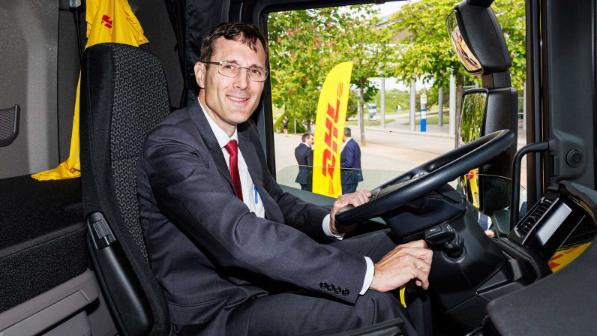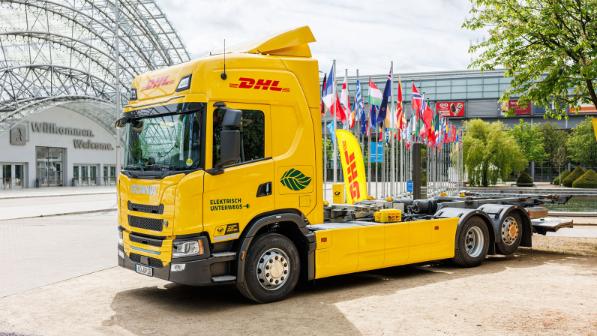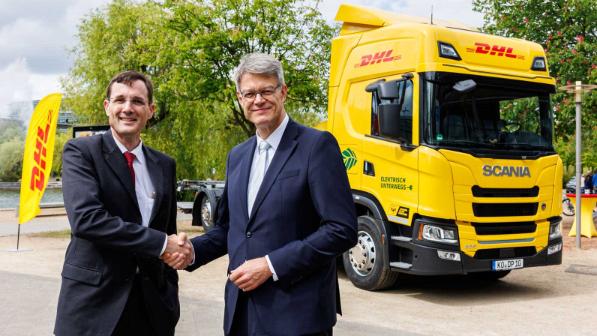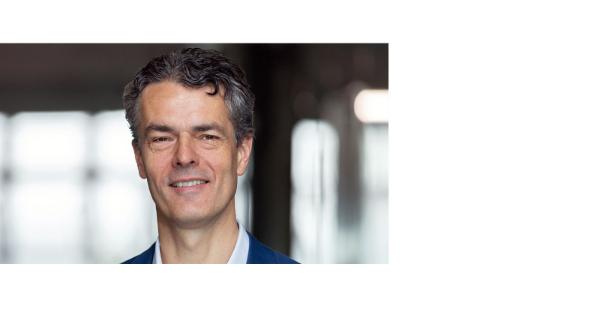100-day DHL test: New Scania e-truck with fuel-powered backup generator saved 90% CO2 emissions
The EREV is an electric truck equipped with a fuel-powered backup generator that generates electricity to recharge the batteries when they are running low.
- DHL presents the "Extended Range Electric Vehicle" (EREV) developed with Scania for the first time at the International Transport Forum in Leipzig
- Key insights after approximately 22,000 kilometers driven: The vehicle provides the necessary operational flexibility and energy reserve, operates 90% of the time in electric mode, and enables stable operations
- Savings of nearly 16 metric tons of CO2e during the testing period
- DHL CEO Tobias Meyer: 'We need pragmatic solutions like the EREV and quick political decisions to enable such bridging technologies. We want to decarbonize the transport sector now and regulation should not hinder but support us to do so.'
Leipzig - DHL Group, today unveiled the 'Extended Range Electric Vehicle' (EREV), developed in collaboration with heavy vehicle maker Scania, at the OECD International Transport Forum in Leipzig. The EREV is an electric truck equipped with a fuel-powered backup generator that generates electricity to recharge the batteries when they are running low. This new truck concept is being extensively tested by DHL for package transport between Berlin and Hamburg. The results after the first 100 days are very positive: the EREV covered nearly 22,000 kilometers, operating more than 90% of the time in electric mode. The range extender was activated in only about 8.1% of the kilometers driven. As a result, the EREV saved more than 90% of CO2 emissions compared to a conventional diesel truck during the testing period. At the same time, it enhances operational flexibility by providing an additional energy reserve when no charging station is available, unlike a fully electric truck. The generator itself cannot directly drive the vehicle's drive axle. In that sense, the EREV is different from conventional hybrid vehicles and a novel concept with great potential to support the transition to electrified transport, both for the transport operator and the transport system. The test between the DHL parcel centers in Berlin and Hamburg demonstrated that the EREV is a practical and, above all, sustainable means of transport for logistics.

However, for bridging technologies like the EREV to gain traction in the transport sector, appropriate regulatory frameworks are needed. Tobias Meyer, CEO of DHL Group, stated: 'We all, businesses, politics, and society - want fewer emissions through increased e-mobility in freight transport. At the same time, all experts know that the transition to fully electric trucks will take many years, primarily because the grid and charging infrastructure are inadequate. But we should not be forced to wait. We need pragmatic solutions like the EREV and quick political decisions to enable such bridging technologies. We want to decarbonize the transport sector now and regulation should not hinder but support us to do so."
The successful test of the EREV has shown that this vehicle's environmental performance can come close to that of a full electric truck. The calculation of road tolls and the emission values for the EU fleet emission scheme should reflect the actual or realistically expected emissions, which is currently not the case for the EREV. A vehicle should pay the CO2 truck toll according to its effective greenhouse gas emissions. Policymakers should support this by introducing an additional emissions class that recognizes proportional CO2 emissions reductions under road toll legislation, based on certified emissions. DHL expressly welcomes the new German government's coalition agreement, which includes support for EREVs, as a step in the right direction, and calls for timely implementation in applicable regulations.

Test details
Since February, the EREV has been used in the Post & Parcel Germany division for transport between the parcel centers in Ludwigsfelde near Berlin and Hamburg. During this time, the truck has covered around 22,000 kilometers and typically traveled the approximately 250-kilometer route on electric power charged from renewable electricity via the grid. On colder days or when facing unpredictable charging difficulties (such as charging stations being occupied or malfunctioning) that require an additional range, the range extender was turned on, serving as a backup offering additional flexibility. This is a significant advantage over fully electric trucks, especially as this facilitates reliable route planning - something that is indispensable in logistics.
In the first phase of the test, the EREV operated over 91.9% of the time using grid-charged energy, with only 8.1% of the energy supplied by the built-in range extender. Compared to a conventional truck, the EREV has so far saved more than 90% of CO2e emissions, resulting in nearly 16 metric tons less CO2e during the testing period than a comparable diesel truck. Going forward, emissions could be further reduced by using fuel from renewable sources, such as biodiesel, for the small share of energy provided through the generator.

Next generation of EREV to have higher battery capacity
The EREV is a 10.5-meter-long truck (excluding a trailer) with a permissible total weight of 40 tons, powered by a 230 kW electric motor (295 kW peak). The energy currently comes from a 416 kWh battery and a fuel-powered 120 kW generator in the prototype. The next version is expected to feature a larger battery with 520 kWh. EREVs can be equipped with software that limits the use of the fuel-powered generator, ensuring a guaranteed reduction in greenhouse gas emissions and capping them at a specific level. The truck's maximum speed is limited to 89 km/h, and it has a capacity of about 1,000 packages (the volume of a swap body). Additionally, the truck can tow a trailer with another swap body.
Necessary political frameworks
Whether DHL will acquire more EREV units depends on the recognition and support of the vehicle in the relevant European and national regulations such as the road toll legislation. The test results in operations have been very positive and promising - the technology is fully ready, and so is DHL.

Alexander Edenhofer
Mail Products & Services, Regulation Issues, Postal Policy, E-Mobility, Bonn Topics
DHL Group
Charles-de-Gaulle-Str. 20
53113 Bonn
Germany
Scania
Corporate and Public Relations Manager
Erik Bratthall
Tel.: +46 76 724 45 27
erik.bratthall@scania.com